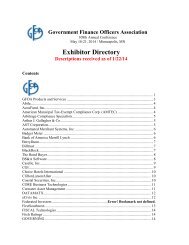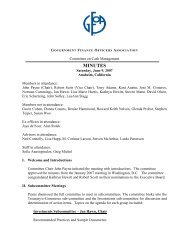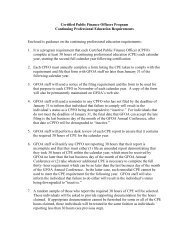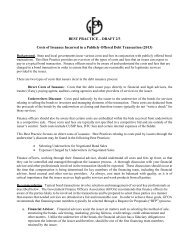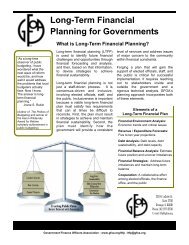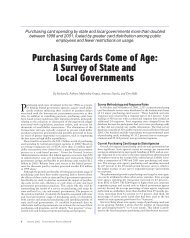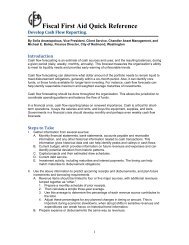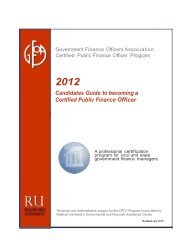Statement 49 — Pollution Remediation Obligations
Statement 49 — Pollution Remediation Obligations
Statement 49 — Pollution Remediation Obligations
You also want an ePaper? Increase the reach of your titles
YUMPU automatically turns print PDFs into web optimized ePapers that Google loves.
<strong>Statement</strong> <strong>49</strong> <strong>—</strong><br />
<strong>Pollution</strong> <strong>Remediation</strong><br />
<strong>Obligations</strong><br />
Wes Galloway, GASB Staff<br />
Smitty – MTSU<br />
1<br />
Disclaimers<br />
The views expressed in this presentation<br />
are those of Mr. Galloway. Official<br />
positions of the GASB are determined<br />
only after extensive due process and<br />
deliberation.<br />
However, Smitty can say whatever he dang<br />
well pleases about any topic, and usually<br />
does!<br />
2<br />
1
GASB’s <strong>Pollution</strong> Project<br />
Project added to research agenda in<br />
2001<br />
• for issues not covered in GASB 18<br />
Preliminary Views issued March 2005<br />
• 39 respondents<br />
• Public hearing<br />
Exposure Draft issued January 2006<br />
• 45 respondents<br />
<strong>Statement</strong><strong>—</strong>November 2006<br />
3<br />
If it’s s toxic,<br />
corrosive,<br />
reactive or explosive,<br />
the waste that you have is a hazard.<br />
If it’s s toxic,<br />
corrosive,<br />
reactive or explosive,<br />
then you have hazardous waste.<br />
4<br />
2
A Survey – how many of you<br />
Prepare your own journal entries?<br />
Prepare your own adjusting entries?<br />
Prepare your own financial statements?<br />
Do your own actuarial calculations?<br />
So, why the heck do you think you are<br />
going to be implementing this standard<br />
on your own?<br />
5<br />
Impact of <strong>Pollution</strong> on<br />
State and Local<br />
Governments<br />
6<br />
3
History of <strong>Pollution</strong> Laws<br />
60’s<strong>—</strong>Growing societal concern<br />
70’s<strong>—</strong><strong>Pollution</strong> PREVENTION Laws<br />
• Clean Air Act of 1970<br />
• Resource Conservation and Recovery Act<br />
of 1976<br />
• Clean Water Act of 1977<br />
• Similar state laws<br />
80’s<strong>—</strong><strong>Pollution</strong> REMEDIATION<br />
Laws<br />
7<br />
Legal Liability Standards<br />
Varies by state and law<br />
• Many are similar to Superfund<br />
Liable under Superfund<strong>—</strong><br />
• Current and previous site owners and<br />
operators<br />
• Disposers<br />
• Transporters<br />
8<br />
4
Legal Liability Standards<br />
Liability under Superfund<strong>—</strong><br />
• Strict<strong>—</strong>responsible without regard to fault<br />
• Joint and several<strong>—</strong>can be held responsible<br />
for entire cleanup effort<br />
States share costs at National Priorities<br />
List sites<br />
• Orphaned Private sites<strong>—</strong>10% of remedy<br />
and 100% of operation and maintenance<br />
• Public facilities<strong>—</strong>50% of all response costs<br />
9<br />
Example<br />
County road<br />
department properly<br />
disposed of paint<br />
stripping chemicals<br />
But recycler did not<br />
5
Legal Liability Standards<br />
Safe harbor (under Superfund<br />
Amendments and Reauthorization Act of<br />
1986), but not in all states<br />
• Foreclosure<br />
• Innocent buyer who exercised due<br />
professional care in acquisition<br />
Site inspection<br />
Site history<br />
Neighboring polluters<br />
11<br />
Map Features<br />
Water dischargers<br />
Superfund<br />
Hazardous waste<br />
Toxic releases<br />
Air emissions<br />
BRS<br />
Multi-activities<br />
Schools<br />
Hospitals<br />
Churches<br />
Populated Places<br />
Streets<br />
Streams<br />
Water Bodies<br />
Zipcodes<br />
Counties<br />
2.0 mi across. Tips: Click on the map or choose another option.<br />
6
Scope of <strong>Pollution</strong><br />
<strong>Remediation</strong><br />
<strong>Obligations</strong> ED<br />
13<br />
<strong>Pollution</strong> REMEDIATION<br />
Obligation to address the current or<br />
potential detrimental effects of existing<br />
pollution by participating in pollution<br />
remediation activities<br />
• Site assessments<br />
• Cleanup, contain, or neutralize hazardous<br />
wastes or hazardous substances<br />
oil, asbestos, lead, and hundreds more<br />
• Regulatory oversight charges<br />
• O&M and monitoring sites<br />
14<br />
7
Issues Excluded From Scope<br />
<strong>Pollution</strong> prevention or control<br />
obligations<br />
Asset retirement obligations<strong>—</strong>including<br />
landfills (<strong>Statement</strong> 18)<br />
Fines, penalties, toxic torts, product or<br />
process safety outlays (NCGA<br />
<strong>Statement</strong> 4)<br />
15<br />
Expected Impact<br />
Does not require any additional<br />
remediation efforts<br />
Governments typically don’t do<br />
remediation without expert advice, so no<br />
additional consultants needed<br />
No major impact on most brownfields<br />
redevelopment efforts<br />
• Often capitalizable<br />
16<br />
8
Accounting for<br />
<strong>Pollution</strong> <strong>Remediation</strong><br />
<strong>Obligations</strong><br />
17<br />
Types of <strong>Remediation</strong><br />
<strong>Obligations</strong><br />
Pre-cleanup activities: site assessment,<br />
feasibility study, design<br />
Cleanup activities: neutralization,<br />
containment, disposal activities<br />
Oversight and enforcement costs<br />
Operation and maintenance of the<br />
remedy and monitoring<br />
18<br />
9
Recognition Threshold<br />
<br />
Determine whether one of more<br />
components of a pollution remediation<br />
obligation are recognizable as a liability<br />
when . . .<br />
1. Government knows or reasonably<br />
believes that a site is polluted, and<br />
2. Obligating event occurs<br />
19<br />
SOP 96-1 Vs. Obligating Events<br />
SOP 96-1 interprets FAS 5<br />
Presumes negative outcome (liability) when<br />
a) “Litigation has commenced or a claim or an<br />
assessment has been asserted or . . . is<br />
probable”<br />
AND<br />
b) “Entity is associated with the site”<br />
Disposed of or transported waste, owned or<br />
operated site<br />
20<br />
10
Obligating Events<br />
a. Compelled to take remediation action<br />
because of pollution-caused imminent<br />
endangerment<br />
b. Violate pollution-prevention permit<strong>—</strong>for<br />
example, RCRA permit<br />
c. Named, or evidence indicates govt. will<br />
be named, as responsible party or PRP<br />
for remediation (or cost sharing)<br />
21<br />
Obligating Events (continued)<br />
d. Named, or evidence indicates govt. will<br />
be named, in lawsuit to participate in<br />
remediation<br />
• Excludes lawsuits having no merit<br />
e. Govt. commences, or legally obligates<br />
self to commence<br />
• Limited to portion legally required to<br />
complete<br />
22<br />
11
Recognition Overview<br />
Component recognition approach<br />
Cost accumulation, not fair value<br />
Current value, not present value<br />
Expected cash flow technique<br />
23<br />
Component Recognition<br />
Recognize COMPONENTS of a liability<br />
only when they become reasonably<br />
estimable<br />
Recognition benchmarks<br />
• For determining when components are<br />
reasonably estimable<br />
• Apply only to more complex/uncommon<br />
sites<br />
• Borrowed from SOP 96-1<br />
24<br />
12
Recognition Benchmarks:<br />
Reevaluate estimated liability<br />
Receipt of administrative order compelling<br />
government to take response action<br />
Participation in site assessment or investigation<br />
Completion of corrective measures feasibility<br />
study<br />
Issuance of authorization to proceed in cleanup<br />
<strong>Remediation</strong> design and implementation,<br />
through and including operation, maintenance,<br />
and postremediation monitoring<br />
25<br />
Cost Accumulation Approach<br />
Measured based on pollution<br />
remediation outlays expected to be<br />
incurred to settle those liabilities<br />
Profits and risk premium should be<br />
included only when the government<br />
expects to use another party to perform<br />
remediation work<br />
26<br />
13
Current Value<br />
What it would cost to do all work now<br />
Based on reasonable and supportable<br />
assumptions about future events<br />
• Approved laws and regulations<br />
• Existing technology expected to be used<br />
27<br />
Expected Cash Flow<br />
FASB introduced this approach in<br />
<strong>Statement</strong> 143 in 2001 (Con. 7)<br />
Also applied in:<br />
• Interpretation No. 45, Guarantor’s<br />
Accounting and Disclosure Requirements<br />
for Guarantees, including indirect<br />
Guarantees of Indebtedness of Others<br />
• Interpretation No. 46 (R), Consolidation of<br />
Variable Interest Entities<br />
• Others<br />
28<br />
14
Expected Cash Flow<br />
Simplified Decision Tree Example<br />
Key Uncertainties for this example<br />
• Cleanup level to be achieved<br />
General residential use<br />
Commercial use<br />
• Depth of soil contamination<br />
1 yard depth<br />
2 yards depth<br />
• <strong>Remediation</strong> technology to be used<br />
Removal and transport to landfill<br />
Gas sparging<br />
Pump & treat<br />
15
Simplified Decision Tree Example<br />
.2<br />
Landfill .04 x $250K<br />
.5<br />
1 yard depth<br />
.5<br />
Sparging .10 x $125K<br />
.4<br />
.3<br />
Pump & treat .06 .<br />
Commercial<br />
.2<br />
Landfill .04 .<br />
.5<br />
2 yards depth .5<br />
Sparging .10 .<br />
.3<br />
Pump & treat .06 .<br />
.2<br />
Landfill .06 .<br />
.5<br />
1 yard depth<br />
.5<br />
Sparging .15 .<br />
.3<br />
.6<br />
Pump & treat .09 .<br />
Residential<br />
.2<br />
Landfill .06 .<br />
.5<br />
2 yards depth .5<br />
Sparging .15 .<br />
.3<br />
Pump & treat .09 .<br />
100%<br />
Which Outlays?<br />
All direct outlays attributable to<br />
remediation<br />
• All outlays<strong>—</strong>not just incremental costs<br />
• Consistent with <strong>Statement</strong> 18<br />
• Includes payroll, pension, and OPEB<br />
May include indirect outlays<br />
• General overhead<br />
• A matter of professional judgment<br />
32<br />
16
Expense or Capitalize?<br />
What could be capitalized:<br />
• All outlays when primary purpose of project<br />
is remediation<br />
• Incremental outlays when primary purpose<br />
is not remediation<br />
Generally an expense<br />
Capitalize in certain situations – do NOT<br />
record liabilities for capitalizable costs<br />
Take into account expected recoveries<br />
33<br />
Capitalization Permitted When:<br />
a. Cleanup to prepare property for sale (limited to<br />
fair value)<br />
b. Polluted property bought and cleaned for use<br />
(limited)<br />
c. Asset impaired and cleanup restores lost<br />
service utility (limited)<br />
d. Acquire PP&E that have future alternative use,<br />
e.g., land (limited to future service utility)<br />
<br />
<br />
For a. & b.<strong>—</strong>capitalize only if incurred within<br />
reasonable period<br />
If project not primarily for pollution remediation,<br />
apply above to incremental outlays attributable<br />
to remediation.<br />
34<br />
17
Expected Recoveries<br />
Two types<br />
• Payments expected from other Potential<br />
Responsible Parties (PRPs)<br />
• Expected insurance recoveries<br />
Measurement<strong>—</strong>based on expected cash<br />
flows and current value<br />
35<br />
Expected Recoveries from<br />
PRPs and Insurance<br />
Reduce expense (and expenditure, if<br />
available) and . . .<br />
If not realized or realizable<strong>—</strong><br />
• Net against remediation liabilities<br />
When realized or realizable<br />
• Accrete liability and report separate<br />
recovery assets (cash or receivable)<br />
36<br />
18
Recoveries example<br />
Expected outlays $10,000<br />
Expected recoveries 3,000<br />
Net remediation expense $7,000<br />
If recovery not realized or realizable:<br />
• <strong>Pollution</strong> remediation liability = $7,000<br />
If recovery realized or realizable:<br />
• Recovery asset (receivable) = $3,000<br />
• <strong>Pollution</strong> remediation liability = $10,000<br />
37<br />
Annual Adjustment<br />
Adjust liability annually for changes<br />
• Inflation or deflation<br />
• Price increases/decreases for specific cost<br />
elements<br />
• Changes in technology<br />
• Changes in laws or regulations<br />
Same approach used in <strong>Statement</strong> 18<br />
38<br />
19
Financial Reporting Display<br />
Government-wide<br />
• Program cost, or<br />
• Special item, or<br />
• Extraordinary item<br />
• No separate display of liability required<br />
Governmental funds<br />
• Expenditures recognized when liquidated<br />
with expendable available resources<br />
• No pollution liability, only payables for<br />
goods and services used<br />
39<br />
Disclosures<br />
For recognized liabilities and recoveries<br />
• Nature and source of the pollution<br />
remediation obligation<strong>—</strong>for example,<br />
federal or state law<br />
• Liability, if not apparent on statement<br />
• Methods and assumptions<br />
• Potential for change in estimate<br />
• Estimated recoveries reducing the liability<br />
40<br />
20
Disclosures<br />
For liabilities (or portions thereof)<br />
not yet recognized because not<br />
reasonably estimable<br />
• General description of nature of the<br />
pollution remediation obligation<br />
• Supersedes FAS 5 disclosure of<br />
“reasonably possible”<br />
41<br />
Effective Date & Transition<br />
Period beginning after December 15,<br />
2007<br />
Measure liabilities at beginning of that<br />
period so beginning net assets can be<br />
restated<br />
Apply retroactively if you have sufficient<br />
objective verifiable information to apply<br />
to prior periods<br />
Early application encouraged<br />
42<br />
21
Implementation Ideas<br />
No need to inventory all polluted sites<br />
Send year-end inquiry to departments<br />
• Similar to contingent liability inquiries, but<br />
for obligating events<br />
Use average costs developed by state<br />
regulators<br />
• Modify to fit site if situation different<br />
43<br />
Questions?<br />
Wesley Galloway<br />
Telephone<strong>—</strong>(203) 847-0700 ext.272<br />
WAGalloway@gasb.org<br />
44<br />
22



